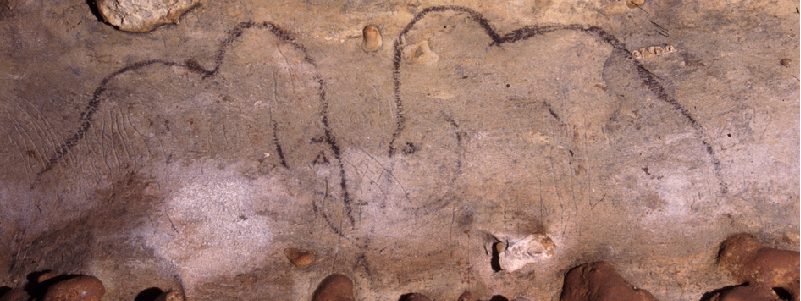By Meredith Mikaelian and Henry Tager
This presentation will discuss both the history and future of mammoth paleontology, and will also share information on some of the most famous mammoth archaeological finds across the globe.
History of Mammoth Paleontology
Mammoth bones have been known to humans for hundreds of years – but we didn’t always know what they were.
The earliest recorded mammoth bones were kept inside St. Stephen’s Catholic Church in Vienna, Austria all the way back in 1443 CE. These bones, and most notably among them a large femur or thigh bone, was thought to be the thigh bone of a “giant” human. It was not until 1613 that a medical student in Lyon, France, named Riolan, correctly identified the so-called “Giant Teutobochus” from Vienna as the skeletal remains of an elephant.
In Gotha, Germany in 1696, the remains of a mammoth was discovered, referred to by the Gotha medical college as an “elephant-shaped freak of nature.” What made this specimen a “freak of nature” was that it displayed several morphological differences when compared to any extant elephant species. At the time, the extinction of species had not yet been discovered; any fossil specimen would therefore be attributed to an extant species living somewhere on earth.
Up until the late 18th century, the different mammoth fossil specimens were strictly classified as extant elephants, and were thought to have been scattered across Europe as a result of purposeful human actions: for example, when the Carthaginian general Hannibal Barca brought his “war elephants” into the Italian Peninsula in the Second Punic War. Mammoth remains found outside the territory of extant elephants were also claimed to have been deposited by the biblical flood, and therefore used as evidence of such an event.
In 1796, a French naturalist named George Cuvier proposed that some mammoth bones he had been examining belonged to a species of “fossil elephant” that was quite well-differentiated from any extant species of elephant. In 1799, following Cuvier’s insight, mammoths received their own scientific name (Elephas primigenius), distinguishing them from all living elephants. This made the mammoth one of the first extinct species ever classified and studied.

New Trends in Mammoth Paleontology
As more intact and well-preserved specimens of mammoth emerge, and as DNA sequencing technologies continue to advance, it becomes more and more plausible that a mammoth clone will be successfully created.
As of 2015, George Church, a geneticist at Harvard University, has already began inserting certain mammoth genes into Asian Elephant embryos using the CRISPR primer. In his research, he extracted the mammoth genes for short ears and long hair, which were retrieved from frozen mammoth cells, and inserted them into embryonic elephant cells. The result of this work is yet unpublished.
Even if these elephants hybrids are successful, scientists still need to figure out how resurrect all the specialized cells required in a fully functional mammoth body, as well as a mechanism for causing these cells to proliferate and differentiate at the appropriate rate.
However, some scientists worry that “de-extinction” technology will de-emphasize habitat and species conservation efforts in the wild. Even if species can be brought back to life, their ecological niche can not always be recreated, and if the niche has changed they might not fit back into it.
For more information on specific mammoth finds around the globe, click any pin on the map below!
To enlarge the map, click the arrows in the bottom right.
Resources
- Lister, Adrian and Paul G. Bahn. Mammoths : Giants of the Ice Age. Berkeley, Calif. : University of California Press, [2007], 2007
- https://news.nationalgeographic.com/news/2007/07/070711-mammoth-picture.html
- https://www.livescience.com/50275-bringing-back-woolly-mammoth-dna.html
- https://www.livescience.com/48625-mummy-woolly-mammoth-brain-revealed.html
- http://www.creationscience.com/onlinebook/FrozenMammoths.html
- https://www.amherst.edu/amherst-story/magazine/issues/2017-fall/loomis-illuminated
- https://www.amherst.edu/news/news_releases/2017/4-2017/a-mammoth-resurrection
- https://www.npr.org/templates/story/story.php?storyId=5173078
